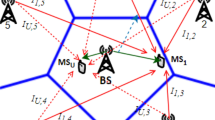Abstract
In this paper, we study the performance of two downlink multicellular systems: a multiple inputs single output (MISO) system using the Alamouti code and a multiple inputs multiple outputs (MIMO) system using the Alamouti code at the transmitter side and a maximum ratio combining (MRC) as a receiver, in terms of outage probability. The channel model includes path-loss, shadowing, and fast fading, and the system is considered interference-limited. Two cases are distinguished: constant shadowing and log-normally distributed shadowing. In the first case, closed form expressions of the outage probability are proposed. For a log-normally distributed shadowing, we derive easily computable expressions of the outage probability. The proposed expressions allow for fast and simple performance evaluation for the two multicellular wireless systems: MISO Alamouti and MIMO Alamouti with MRC receiver. We use a fluid model approach to provide simpler outage probability expressions depending only on the distance between the considered user and its serving base station.











Similar content being viewed by others
References
Cheikh DB, Kelif J-M, Coupechoux M, Godlewski P (2010) Outage probability in a multi-cellular network using Alamouti scheme. In: Proc of IEEE Sarnoff symposium, Princeton, NJ, USA
Foschini GJ, Gans MJ (1998) On limits of wireless communications in a fading environment when using multiple antennas. Wirel Pers Commun 6(3):311–335
Telatar E (1995) Capacity of multi-antenna Gaussian channels. Technical report, AT & T Bell Labs
Zheng L, Tse DNC (2003) Diversity and multiplexing: a fundamental tradeoff in multiple-antenna channels. IEEE Trans Inf Theory 49(5):1073–1096
Tarokh V, Jafarkhani H, Calderbank AR (1999) Space-time block codes from orthogonal designs. IEEE Trans Inf Theory 45(5):1456–1467
Alamouti SM (1998) A simple transmit diversity technique for wireless communications. IEEE J Sel Areas Commun 16(8):1451–1458
Alouini M-S, Simon MK (2001) Performance analysis of coherent equal gain combining over Nakagami-m fading channels. IEEE Trans Veh Technol 50(6):1449–1463
Kang M, Yang L, Alouini M-S (2006) Outage probability of MIMO optimum combining in presence of unbalanced co-channel interferers and noise. IEEE Trans Wirel Commun 5(7):1661–1668
Shah A, Haimovich A (2000) Performance analysis of maximum ratio combining and comparison with optimum combining for mobile radio communications with cochannel interference. IEEE Trans Veh Technol 49(4):1454–1463
Yang L (2007) Outage performance of OSTBC in double scattering MIMO channels. Wirel Pers Commun 45:225–230
Chen Z, Yuan J, Vucetic B, Zhou Z (2003) Performance of Alamouti scheme with transmit antenna selection. Electron Lett 39(23):1666–1668
Schnurr C, Stanczak S, Sezgin A (2007) The impact of different MIMO strategies on the network outage performance. In: Proc of international ITG/IEEE workshop on smart antennas, Vienna, Austria
Chalise BK, Czylwik A (2008) Exact outage probability analysis for a multiuser MIMO wireless communication system with space-time block coding. IEEE Trans Veh Technol 57(3):1502–1512
Li L, Vorobyov SA, Gershman AB (2009) Transmit antenna selection based strategies in MISO communication systems with low-rate channel state feedback. IEEE Trans Wirel Commun 8(4):1660–1666
Reider N, Fodor G (2010) On opportunistic power control for MIMO-OFDM systems. In: Proc of 6th IEEE broadband wireless access (BWA) workshop, Miami, FL, USA
Lopez-Martinez FJ, Martos-Naya E, Wong K-K, Entrambasaguas JT (2011) Closed-form BER analysis of Alamouti-MRC systems with ICSI in ricean fading channels. IEEE Commun Lett 15(1):46–48
Rahman M, de Carvalho E, Prasad R (2007) Impact of MIMO co-channel interference. In: Proc of IEEE personal, indoor, mobile radio communications conference (PIMRC), Athens, Greece
Choi W, Himayat N, Talwar S, Ho M (2007) The effects of co-channel interference on spatial diversity techniques. In: Proc of IEEE wireless communications and networking conference (WCNC), Hong Kong, China
Li Y, Cimini L, Himayat N (2008) Performance analysis of space time block coding with co-channel MIMO interferers. In: Proc of IEEE global communications conference (GLOBECOM), New Orleans, LA
Holm H, Alouini M-S (2004) Sum and difference of two squared correlated Nakagami variates in connection with the McKay distribution. IEEE Trans Commun 52(8):1367–1376
Papoulis A (1962) The Fourier integral and its applications. McGraw-Hill, New York
Simon MK, Alouini M-S (2005) Digital communication over fading channels, 2nd edn. Wiley, New York
Kelif J-M, Altman E (2005) Downlink fluid model of CDMA networks. In: Proc of IEEE Veh Tech conference (VTC Spring), Stockolm, Sweden
Cheikh DB, Kelif J-M, Coupechoux M, Godlewski P (2011) SIR distribution analysis in cellular networks considering the joint impact of path-loss, shadowing and fast fading. EURASIP J Wirel Comm Netw 2011(1):1–10. Article 137
Kélif J-M, Coupechoux M, Godlewski Ph (2010) A fluid model for performance analysis in cellular networks. EURASIP J Wirel Comm Netw 2010(1):1–11. Article 435189
Author information
Authors and Affiliations
Corresponding author
Additional information
Part of the results presented in this paper have been published in [1].
Appendix: Independence result
Appendix: Independence result
In this appendix, we recall an independence result presented in [9]. Consider zero mean complex Gaussian vectors \(\textbf{h}_{0}=[h_{1,0},h_{2,0},...,h_{N,0}]^{H}\) and \(\textbf{h}_{j}=[h_{1,j},h_{2,j},...,h_{N,j}]^{H}\) and let g j be a random variable given by
Since the elements of \(\textbf{h}_{j}\) are i.i.d zero mean complex Gaussian, g j conditioned on \(\textbf{h}_{0}\) is also zero mean complex Gaussian. The mean and the variance of g j can be calculated as follows:
\(\textbf{I}_{N}\) being the identity matrix of dimension N.
The pdf of g j conditioned on \(\textbf{h}_{0}\) can thus be written as
From the expression of the pdf, it can be clearly stated that g j is independent of \(\textbf{h}_{0}\).
Rights and permissions
About this article
Cite this article
Cheikh, D.B., Kelif, JM., Coupechoux, M. et al. Multicellular Alamouti scheme performance in Rayleigh and shadow fading. Ann. Telecommun. 68, 345–358 (2013). https://doi.org/10.1007/s12243-012-0329-4
Received:
Accepted:
Published:
Issue Date:
DOI: https://doi.org/10.1007/s12243-012-0329-4




